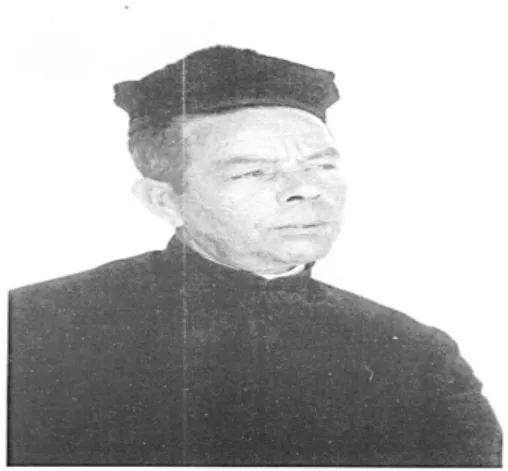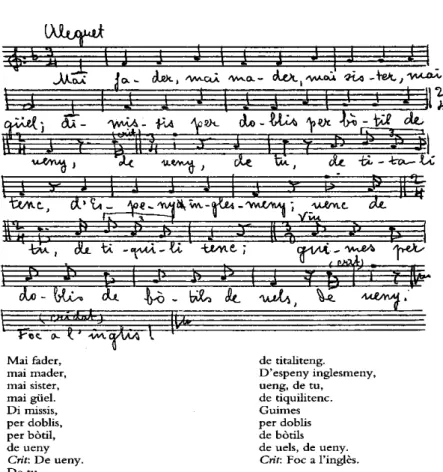Estudos de Literatura Oral, 6 (2000), pp. 77-‐82
BALEARIC ISLANDS
Simon Furey*
During the Second World War, the US soldiers who came to Britain as allies were often less than welcome to their hosts. "Over paid, oversexed and over here" was a frequently-‐heard moan. I have news for my American friends; we British have no right to complain, because we were doing the same thing ourselves to other people over a hundred years earlier! The evidence for this lies in a song published in Materials de l'obra del cançoner
popular de Catalunya (OCPC).
For those who have not encountered the OCPC, I should explain that in 1921 an ambitious project was undertaken to collect all of the folk songs of the països catalans. Small teams were sent to all points, near and far, to collect both words and music. They were successful beyond their wildest imaginings, and collected many thousands of songs. Meanwhile, back in Barcelona, another team had the unenviable task of editing the material into published volumes that contained not only the songs but background information and commentary on Catalan folk music. The editorial team was swamped, and as the years went by the backlog of unpublished material became enormous. The situation was further complicated by political instability in the region. Collection came to a halt in 1936 when a team member was murdered, although a limited amount of editorial work continued during the civil war until 1938. Over the period of the OCPC activity five books were produced, three of which contained songs collected up to 1925.
Following Franco's victory in 1939, Catalan culture was suppressed and much material was destroyed. Fortunately, the OCPC papers were hidden away and preserved almost entirely. In the early 1990s a project began at Montserrat Abbey, outside Barcelona, to publish the materials under the supervision of Pare Josep Massot i Muntaner. Publication began in 1993 at the rate of one volume per year, and Pare Massot estimates that it will be nearly 2010 before selections of all of the material have been published.
The newer publications differ from the pre-‐war ones in one important respect. Instead of printed scores that are the result of editorial work and amendment, facsimiles of the original collected musical notation are included. This means that the reader can analyse the original field notes and see where the singer has probably varied the performance and the collector
*
Department of Hispanic Studies. Arts Tower. University of Sheffield. Western Bank. Sheffield. South Yorkshire S10 2TN. United Kingdom. <simon.furey@btinternet.com>
has attempted to record the variations. The disadvantage is that mistakes, omissions and inconsistencies caused by the method of recording are visible. Unfortunately, where uncertainties exist, it is no longer possible to ask the collectors what the right interpretation should be. That said, one can only marvel at the quality of the notation in the books so far published, given that it was done in the field entirely without phonographic recording apparatus.
In the meantime, it is a joy to receive each year another large grey volume, full of treasures ripe for exploration and discovery. It is just such a discovery that I made in Volume VIII of the OCPC Materials published in 1998. This volume contains the first results published so far of the OCPC field research in the island of Minorca.
Minorca was occupied by the British military for almost the whole of the 18th century. It was therefore interesting to me to find an example of English used in a folk song from there.1 The accompanying notes made by
Baltasar Samper, who collected the song in 1927, indicate that the song was obtained from Mgr. Antoni Orfila, the curate of Sant Lluís, who learnt it from some peasants in the village of Biniancollet. The song came from their grandfathers, who knew it as one of their "Latin songs," and it had thus come down at least two generations.
Figure 1 : Mgr. Antoni Orfila
The song is interesting on a number of counts. First, in spite of oral transmission, the words are relatively ungarbled. Second, either the priest who passed on the song knew no English or he was broad-‐minded! Here is the complete song, which like the photograph above is reproduced from
Materials:
1
Francesc Pujol and others (ed.), Materials de l'obra del cançoner popular de Catalunya, VIII, Barcelona, Abadia de Montserrat, 1998, p. 343.
Figure 2 : The Song Mai fader
Careful examination reveals that the words handwritten on the score are not quite the same as the words printed underneath it. Here are the words as transcribed from the score:
Mai fader Mai mader Mai sister Mai güel. Di missis per doblis per bòtil de ueny
Crit: De ueny!
De tu de titali tenc
D'Espeny inglesmeny ueng, de tu,
de tiquili tenc. Guimes per doblis de bòtils de uels
Crit: De ueny! Crit: Foc a l'inglis!
These are the collected words, not the result of later editing. They provide an excellent example of where the work of Pare Massot is of real benefit, because we can see the music score and text as collected on the mission. A case in point is the word inglis which makes more sense to me in an English/Catalan macaronic song than the Castilian inglès, which is what appears in the edited text (although I concede that inglès is an established Minorcan form, often replacing the standard Catalan anglès). Replacing the accented -‐è-‐ with an unaccented -‐i-‐ shifts the stress to the first syllable, so that the word sounds like "English". It is also clear thet the collector thought the singer said "Espenya" {Spain?) at one point, before correcting what he had written. Pronunciation is key to my interpretation, which I give in the following glossary.
ORIGINAL WORD/PHRASE INTERPRETATION
Mai My
fader father
mader mother
güel girl
Di The
missis missus (= mistress = wife)
per pay or per
doblis obsolete copper coins (doblers)
bòtil bottle
de the or of
ueny, ueng wine
titali tenc titillating
espeny Spain
tiquili tenc tickling (garbled)
Guimes Guineas
uels girls
Figure 3 : Glossary of Macaronic Words
I have discussed this song in correspondence with Pare Massot. He conceded that he saw no meaning in the words other than a parallel to a common saying in the Balearics about the English language, which he quoted:
S'inglès és molt fàcil. Veri güel vol dir Miquel, veri gut vol dir llaüt, i tot lo altre com noltros.
In fact, the only thing this saying has in common with the song Mai
fader is the word güel. In the above example the English phrases are, of
course "very well" and "very good."
Most of my interpretations are straightforward and, I believe, uncontentious. However, taking uels to mean "girls" may be less so. I have taken it by its similarity to güel that appears earlier. Clearly, to make any sense neither of these words relates to "well" as in Pare Massot's example. Taken all together, then, the meaning of the words of the song is quite explicit, if lacking in grammatical sense, and says, "My family can buy wine for coppers. You sell wine and titillation to Englishmen coming over from Spain. Now you want payment in guineas not doblers. Give us the wine, and to hell with all English!" What we have here in my view is a tavern or brothel song relating to the singer's unwillingness to pay the inflated prices brought about by the British military occupation. It is not a British song; I imagine it to be locally composed in Minorca. I date it from probably the 18th or early 19th century; the second verse refers to Englishmen coming from Spain, as happened during the Peninsular War. Likely as not, the officers would have had guineas to spend instead of the local currency. I have checked my interpretation with Pare Massot, who in a letter to me said that he found it bastant plausible. He differs, however, in the interpretation of the word doblis, which he takes to mean dobles rather than doblers. In context this will mean either doubled prices or double guineas. He may be right.
The music of the song is also interesting. The first verse has a different tune to the second (assuming we divide the song at the first crit). The second tune I do not recognise, but the first is clearly the well-‐known tune used for the Lourdes Hymn, Immaculate Mary. The miraculous visions of Bernadette Soubirous occurred in 1858 and the Pope declared them authentic in 1862. The tune is quoted in hymn books as being "French
traditional" and the English and Latin words are anonymous. I have no other information on it, except that variants of the tune are used with other folk songs in Catalan, for example El minyó de Villeres.2 I do not know at
what stage the Lourdes hymn became popular; it may be later than when this strange macaronic song was collected in Minorca. Today, of course, such a combination of tune and words is likely to appear highly irreverent to devout Roman Catholics.
According to Pare Massot, this song is an isolated instance; he knows of no other English/Catalan macaronic songs in the OCPC materials, published or unpublished, or indeed in any other collection. I have not found any other English occurrences in Catalan folk songs either; not even any instances of single words. Nevertheless, I shall be examining future volumes of Materials with increased interest. I am also looking forward to being able eventually to examine the corpus of OCPC collected songs, when Pare Massot makes it readily available in its entirety and when I and others have enough time to make proper examination of such an enormous amount of primary material.
WORKS CITED
Francesc Pujol and others (ed.), Materials de l'obra del cançoner popular de
Catalunya, Barcelona, Fundació C. Rabell i Cibils, 1926-‐1929 / Barcelona,
Abadia de Montserrat, 1993-‐ , 8 vols.
ABSTRACT
The work at l'Abadia de Montserrat by Pare Josep Massot i Muntaner in publishing Materials de l'obra del cançoner popular de Catalunya continues to bear fascinating fruit. Volume VIII, published in 1998, contains the only known instance thus far of a song in Macaronic English. This brief paper argues that the song dates from the time of the British occupation of Minorca in the 18th century.

